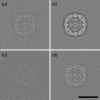Enabling direct nanoscale observations of biological reactions with dynamic TEM
- PMID: 23315566
- PMCID: PMC3582344
- DOI: 10.1093/jmicro/dfs081
Enabling direct nanoscale observations of biological reactions with dynamic TEM
Abstract
Biological processes occur on a wide range of spatial and temporal scales: from femtoseconds to hours and from angstroms to meters. Many new biological insights can be expected from a better understanding of the processes that occur on these very fast and very small scales. In this regard, new instruments that use fast X-ray or electron pulses are expected to reveal novel mechanistic details for macromolecular protein dynamics. To ensure that any observed conformational change is physiologically relevant and not constrained by 3D crystal packing, it would be preferable for experiments to utilize small protein samples such as single particles or 2D crystals that mimic the target protein's native environment. These samples are not typically amenable to X-ray analysis, but transmission electron microscopy has imaged such sample geometries for over 40 years using both direct imaging and diffraction modes. While conventional transmission electron microscopes (TEM) have visualized biological samples with atomic resolution in an arrested or frozen state, the recent development of the dynamic TEM (DTEM) extends electron microscopy into a dynamic regime using pump-probe imaging. A new second-generation DTEM, which is currently being constructed, has the potential to observe live biological processes with unprecedented spatiotemporal resolution by using pulsed electron packets to probe the sample on micro- and nanosecond timescales. This article reviews the experimental parameters necessary for coupling DTEM with in situ liquid microscopy to enable direct imaging of protein conformational dynamics in a fully hydrated environment and visualize reactions propagating in real time.
Figures





Similar articles
-
Visualizing macromolecular complexes with in situ liquid scanning transmission electron microscopy.Micron. 2012 Nov;43(11):1085-90. doi: 10.1016/j.micron.2012.01.018. Epub 2012 Feb 15. Micron. 2012. PMID: 22386621 Free PMC article.
-
4D electron microscopy: principles and applications.Acc Chem Res. 2012 Oct 16;45(10):1828-39. doi: 10.1021/ar3001684. Epub 2012 Sep 11. Acc Chem Res. 2012. PMID: 22967215
-
Laser-based in situ techniques: novel methods for generating extreme conditions in TEM samples.Microsc Res Tech. 2009 Mar;72(3):122-30. doi: 10.1002/jemt.20664. Microsc Res Tech. 2009. PMID: 19165740
-
Tackling the Challenges of Dynamic Experiments Using Liquid-Cell Transmission Electron Microscopy.Acc Chem Res. 2018 Jan 16;51(1):3-11. doi: 10.1021/acs.accounts.7b00331. Epub 2017 Dec 11. Acc Chem Res. 2018. PMID: 29227618 Review.
-
Graphene-Assisted Electron-Based Imaging of Individual Organic and Biological Macromolecules: Structure and Transient Dynamics.ACS Nano. 2025 Jan 14;19(1):120-151. doi: 10.1021/acsnano.4c12083. Epub 2024 Dec 26. ACS Nano. 2025. PMID: 39723464 Review.
Cited by
-
Glucose starvation triggers filamentous septin assemblies in an S. pombe septin-2 deletion mutant.Biol Open. 2019 Jan 2;8(1):bio037622. doi: 10.1242/bio.037622. Biol Open. 2019. PMID: 30602528 Free PMC article.
-
Stimuli-responsive nanomaterials for biomedical applications.J Am Chem Soc. 2015 Feb 18;137(6):2140-54. doi: 10.1021/ja510147n. Epub 2015 Feb 6. J Am Chem Soc. 2015. PMID: 25474531 Free PMC article.
-
An introduction to sample preparation and imaging by cryo-electron microscopy for structural biology.Methods. 2016 May 1;100:3-15. doi: 10.1016/j.ymeth.2016.02.017. Epub 2016 Feb 28. Methods. 2016. PMID: 26931652 Free PMC article.
-
Cryogenic electron ptychographic single particle analysis with wide bandwidth information transfer.Nat Commun. 2023 May 25;14(1):3027. doi: 10.1038/s41467-023-38268-0. Nat Commun. 2023. PMID: 37230988 Free PMC article.
-
Atomic-Resolution Imaging of Fast Nanoscale Dynamics with Bright Microsecond Electron Pulses.Nano Lett. 2021 Jan 13;21(1):612-618. doi: 10.1021/acs.nanolett.0c04184. Epub 2020 Dec 10. Nano Lett. 2021. PMID: 33301321 Free PMC article.
References
-
- Kendrew J C, Bodo G, Dintzis H M, Parrish R G, Wyckoff H, Phillips D C. A three-dimensional model of the myoglobin molecule obtained by x-ray analysis. Nature. 1958;181:662–666. - PubMed
-
- Watson J D, Crick F H. The structure of DNA. Cold Spring Harb. Symp. Quant. Biol. 1953;18:123–131. - PubMed
-
- Available from: http://www.rcsb.org/pdb/statistics/holdings.do .
-
- Boutet S, Lomb L, Williams G J, Barends T R M, Aquila A, Doak R B, Weierstall U, DePonte D P, Steinbrener J, Shoeman R L, Messerschmidt M, Barty A, White T A, Kassemeyer S, Kirian R A, Seibert M M, Montanez P A, Kenney C, Herbst R, Hart P, Pines J, Haller G, Gruner S M, Philipp H T, Tate M W, Hromalik M, Koerner L J, van Bakel N, Morse J, Ghonsalves W, Arnlund D, Bogan M J, Caleman C, Fromme R, Hampton C Y, Hunter M S, Johansson L, Katona G, Kupitz C, Liang M, Martin A V, Nass K, Redecke L, Stellato F, Timneanu N, Wang D, Zatsepin N A, Schafer D, Defever J, Neutze R, Fromme P, Spence J C H, Chapman H N, Schlichting I. High-resolution protein structure determination by serial femtosecond crystallography. Science. 2012;337:362–364. - PMC - PubMed
-
- Chapman H N, Fromme P, Barty A, White T A, Kirian R A, Aquila A, Hunter M S, Schulz J, DePonte D P, Weierstall U, Doak R B, Maia F R, Martin A V, Schlichting I, Lomb L, Coppola N, Shoeman R L, Epp S W, Hartmann R, Rolles D, Rudenko A, Foucar L, Kimmel N, Weidenspointner G, Holl P, Liang M, Barthelmess M, Caleman C, Boutet S, Bogan M J, Krzywinski J, Bostedt C, Bajt S, Gumprecht L, Rudek B, Erk B, Schmidt C, Homke A, Reich C, Pietschner D, Struder L, Hauser G, Gorke H, Ullrich J, Herrmann S, Schaller G, Schopper F, Soltau H, Kuhnel K U, Messerschmidt M, Bozek J D, Hau-Riege S P, Frank M, Hampton C Y, Sierra R G, Starodub D, Williams G J, Hajdu J, Timneanu N, Seibert M M, Andreasson J, Rocker A, Jonsson O, Svenda M, Stern S, Nass K, Andritschke R, Schroter C D, Krasniqi F, Bott M, Schmidt K E, Wang X, Grotjohann I, Holton J M, Barends T R, Neutze R, Marchesini S, Fromme R, Schorb S, Rupp D, Adolph M, Gorkhover T, Andersson I, Hirsemann H, Potdevin G, Graafsma H, Nilsson B, Spence J C. Femtosecond X-ray protein nanocrystallography. Nature. 2011;470:73–77. - PMC - PubMed
Publication types
MeSH terms
Substances
Grants and funding
LinkOut - more resources
Full Text Sources
Other Literature Sources

